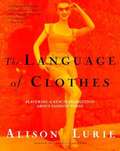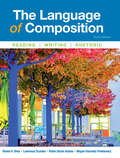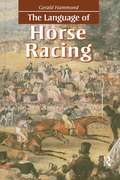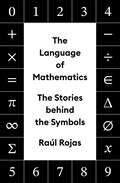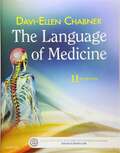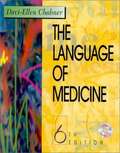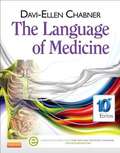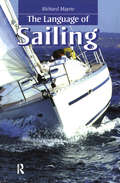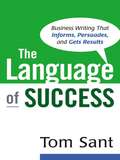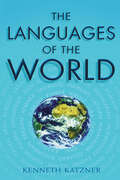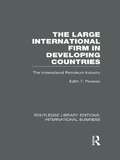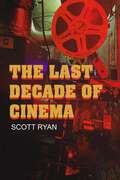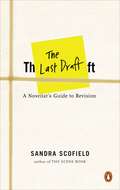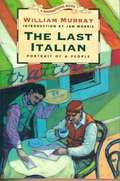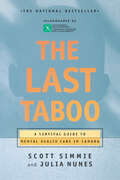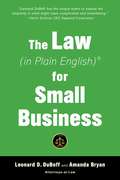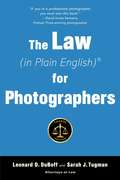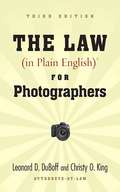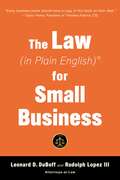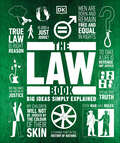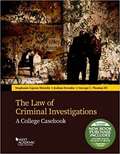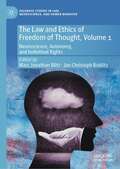- Table View
- List View
The Language of Clothes
by Alison Lurie Doris PalcaThe classic book about the clothes we wear and what they say about us. Even before we speak to someone in a meeting, at a party, or on the street, our clothes often express important information (or misinformation) about our occupation, origin, personality, opinions, and tastes. And we pay close attention to how others dress as well; though we may not be able to put what we observe into words, we unconsciously register the information, so that when we meet and converse we have already spoken to one another in a universal tongue. Alison Lurie, the Pulitzer Prize-winning novelist, is our savvy guide and interpreter on this tour through the history of fashion. She provides fascinating insights into how changing sex roles, political upheavals, and class structure have influenced costume. Whether she is describing the enormous amount of clothing worn by early Victorian women or illuminating the significance of the long robes worn by aging men throughout history to connote eminence, her analysis is playful, clever, and always on target.
The Language of Composition: Reading, Writing, Rhetoric
by Renée H. Shea Lawrence Scanlon Robin Dissin Aufses Megan Harowitz PankiewiczFor over a decade, The Language of Composition has been the most successful textbook written for the AP® English Language and Composition Course. Now, its esteemed author team is back, giving practical instruction geared toward training students to read and write at the college level. The textbook is organized in two parts: opening chapters that develop key rhetoric, argument, and synthesis skills; followed by thematic chapters comprised of the finest classic and contemporary nonfiction and visual texts. With engaging readings and reliable instruction, The Language of Composition gives every students the opportunity for success in AP® English Language.
The Language of Horse Racing
by Gerald HammondIn dictionary form but offering much more than dictionary definitions, The Language of Horse Racing presents a guide to the history, development and usage of words and phrases employed on the racecourse, by those who train and look after horses, those who ride them, and those who lose their money betting on them. Here the reader will discover exactly what the distance is, and why it is so called; what the cap was in handicap; what relation the wild goose chase had to the steeple-chase; what is dead about a dead heat; and what the differences are between getting in, getting on, getting out and getting up. The Language of Horse Racing also reveals the language of the racecourse, including the bizarre vocabulary of betting, from the betting boots that early bookies put on, to the faces, heads, sharks and sharps who feed off the buzz and whisper that go round the ring.
The Language of Law and Economics
by Francesco ParisiFrom a historical perspective, 'law and economics' constituted one of the most influential developments in legal scholarship in the twentieth century; the discipline remains today one of the dominant perspectives on the law, generating a tremendous quantity of new research and discussion. Unfortunately, one consequence of applying the analytical methods of one highly technical field to the historically layered substance of another has been the accumulation of considerable technical overhead, requiring fluency in both the language of economics and the language of the law. Further complicating matters, the field of law and economics has sometimes developed independently, creating new terms, while recasting others from their original economic or legal meanings. In this dictionary of law and economics, Francesco Parisi provides a comprehensive and concise guide to the language and key concepts underlying this fecund interdisciplinary tradition. The first reference work of its kind, it will prove to be an invaluable resource for professionals, students and scholars.
The Language of Law and the Foundations of American Constitutionalism
by Gary L. McdowellFor much of its history, the interpretation of the United States Constitution presupposed judges seeking the meaning of the text and the original intentions behind that text, a process that was deemed by Chief Justice John Marshall to be "the most sacred rule of interpretation. " Since the end of the nineteenth century, a radically new understanding has developed in which the moral intuition of the judges is allowed to supplant the Constitution's original meaning as the foundation of interpretation. The Founders' constitution of fixed and permanent meaning has been replaced by the idea of a "living" or evolving constitution. Gary L. McDowell refutes this new understanding, recovering the theoretical grounds of the original Constitution as understood by those who framed and ratified it. It was, he argues, the intention of the Founders that the judiciary must be bound by the original meaning of the Constitution when interpreting it.
The Language of Mathematics: The Stories behind the Symbols
by Raúl RojasA marvelous compendium of mathematical symbols and their fascinating historiesGalileo famously wrote that the book of nature is written in mathematical language. The Language of Mathematics is a wide-ranging and beautifully illustrated collection of short, colorful histories of the most commonly used symbols in mathematics, providing readers with an engaging introduction to the origins, evolution, and conceptual meaning of each one.In dozens of lively and informative entries, Raúl Rojas shows how today&’s mathematics stands on the shoulders of giants, mathematicians from around the world who developed mathematical notation through centuries of collective effort. He tells the stories of such figures as al-Khwārizmī, René Descartes, Joseph-Louis Lagrange, Carl Friedrich Gauss, Augustin-Louis Cauchy, Karl Weierstrass, Sofia Kovalevskaya, David Hilbert, and Kenneth Iverson. Topics range from numbers and variables to sets and functions, constants, and combinatorics. Rojas describes the mathematical problems associated with different symbols and reveals how mathematical notation has sometimes been an accidental process. The entries are self-contained and can be read in any order, each one examining one or two symbols, their history, and the variants they may have had over time.An essential companion for math enthusiasts, The Language of Mathematics shows how mathematics is a living and evolving entity, forever searching for the best symbolism to express relationships between abstract concepts and to convey meaning.
The Language of Medicine
by Davi-Ellen ChabnerThe Language of Medicine, 11th Edition presents medical terms within the context of the body's anatomy and physiology, and in health and disease. The reader will learn a working medical vocabulary built on the most frequently encountered prefixes, suffixes, and combining forms. Practical exercises and case studies make learning more interesting and demonstrate how medical terms are used in practice.
The Language of Medicine (6th edition)
by Davi-Ellen ChabnerTerminology and complex medical processes are described in an easy-to-understand manner that is readily accessible to learners of all levels. The Language of Medicine brings medical terms to life with a text/workbook format organized by body systems, offering additional chapters on specific key areas of health care.
The Language of Medicine (Tenth Edition)
by Davi-Ellen ChabnerBring medical terminology to life with Davi-Ellen Chabner's bestselling The Language of Medicine, 10th Edition By presenting medical terms within the context of the body's anatomy and physiology, and in health and disease, this proven resource makes it easy to learn a working medical vocabulary built on the most frequently encountered prefixes, suffixes, and combining forms. Practical exercises and case studies demonstrate how medical terms are used in practice. Add an engaging student Evolve website with medical animations and videos, word games, flash cards, and more, and you'll be ready to communicate confidently in the clinical setting and succeed in your healthcare career.
The Language of Organizational Styling
by Lionel WeeThe ways in which commercial organizations and service providers 'style' themselves - creating the image they wish to portray to their potential consumers - is a long-established area of research in the fields of sociology and business studies. However language also plays an important role in organizational styling, something which until now has been largely overlooked in the literature. This is the first book-length study of the linguistics of organizational styling, looking at the language and semiotic resources used by holiday resorts, pharmaceutical companies, restaurants and insurance companies in order to project their identities, and style themselves. It discusses in detail a number of case studies and presents an innovative take on the notion of style, as well as bringing together work from linguistics, business studies and sociology. This interdisciplinary book will be of interest to scholars and advanced students in sociolinguistics, and scholars of sociology and business studies.
The Language of Sailing
by Richard MayneThere have been many dictionaries explaining to laymen the technical terms of sailing. None of them, until now, has systematically set out to explore their etymology and evolution. The Language of Sailing demonstrates that many of the American and British words in question are derived-- often in complex and controversial ways--from other languages, mainly European. The diction of the sea, in fact, is a huge and hybrid skein, much of it traceable as far back as Sanskrit. It reveals that seafaring knitted Europeans together, sometimes in conflict and rivalry, often also in comradeship, when sailing crews could be as multinational as today's international conglomerates. The Language of Sailing is not intended simply for the entertainment of sailors and scholars. Anyone interested in the literature of the sea will find here an unusual and suggestive resource.
The Language of Success: Business Writing That Informs, Persuades, And Gets Results
by Tom SantLanguage is the medium of business. To be successful, we need to communicate effectively in writing. That’s true whether we are providing instructions to our colleagues, communicating with our customers, or advising our direct reports. We must be able to deliver clear, accurate messages that inform, persuade and motivate. Unfortunately, people lapse into habits that interfere with their ability to communicate. The Language of Success shows readers ho to avoid these mistakes, and to write lucid, concise, and accurate e-mails, letters, performance appraisals, and presentations. Now anyone can master the lost art of clear writing and: * eliminate ambiguities, jargon and grandiose claims * master proper paragraph structure so the message doesn’t get muddled * avoid wishy-washy or misleading terms like "world class" or "state of the art" * write clear concise sentences that follow the "first time right rule" * use e-mail professionally and efficiently * create career-enhancing reports Honest and authoritative, The Language of Success will gives readers practical techniques to help readers cut through the fluff, guff, geek, and hyperbole, write exceptional business documents, and get their message heard.
The Languages of the World
by Kenneth Katzner Kirk MillerThis third edition of Kenneth Katzner's best-selling guide to languages is essential reading for language enthusiasts everywhere. Written with the non-specialist in mind, its user-friendly style and layout, delightful original passages, and exotic scripts, will continue to fascinate the reader. This new edition has been thoroughly revised to include more languages, more countries, and up-to-date data on populations.Features include:*information on nearly 600 languages*individual descriptions of 200 languages, with sample passages and English translations*concise notes on where each language is spoken, its history, alphabet and pronunciation*coverage of every country in the world, its main language and speaker numbers*an introduction to language families
The Large International Firm: The International Petroleum Industry (Routledge Library Editions: International Business)
by Edith PenroseThis book is a study of the economics of the large international firm, but is at the same time a study of one of the world’s most important industries. International firms face difficult problems in attempting to deal with the conflicts between their own interest as world-wide economic organisations on the one hand, that of the countries in which they operate on the other, and with the conflicts of interest among the countries which are related to the international policies of the firms. The author analyses the underlying problems and points to possible solutions. When it was first published this was the first book by a professional economist to look widely at the economics of the international petroleum industry outside the industrialized countries.
The Last Decade of Cinema: Twenty-five Unique Films From The Nineties
by Scott RyanThis provocative tome, sure to foment heated discussions among cinephiles of all generations, argues that the 1990s was the last decade in which films were made for grownups, with complex, adult-based plots, nuanced characters, and meaningful themes.&“I feel like Scott Ryan could have written this directly to me and others in our generation who have basically &‘given up&’ on movies. It is at once tribute and eulogy, so bittersweet.&” – Screenwriter Helen Childress (Reality Bites)&“The nineties are lucky to have Scott Ryan.&” – Actress Natasha Gregson Wagner (Two Girls and a Guy, Lost Highway)Ah, the nineties. Movies were something in those days. We&’re talking about a decade that began with GoodFellas and ended with Magnolia, with such films as Malcolm X, Before Sunrise, and Clueless arriving somewhere in between. Stories, characters, and writing were king; IP, franchise movies, and supersaturated superhero flicks were still years away. Or so says Scott Ryan, the iconoclastic author of The Last Days of Letterman and Moonlighting: An Oral History, who here turns his attention to The Last Decade of Cinema—the prolific 1990s. Ryan, who watched just about every film released during the decade when he was a video store clerk in a small town in Ohio, identifies twenty-five unique and varied films from the decade, including Pretty Woman, Pulp Fiction, Menace II Society, The Prince of Tides, and The Shawshank Redemption, focusing with his trademark humor and insight on what made them classics and why they could never be produced in today&’s film culture. The book also includes interviews with writers, directors, and actors from the era. Go back to the time of VCR&’s, DVD rentals, and movies that mattered. Turn off your streaming services, put down your phones, delete your Twitter account, and take a look back at the nineties with your Eyes Wide Shut, a White Russian in your hand, and yell &“Hasta la vista, baby&” to today&’s meaningless entertainment. Revel in the risk-taking brilliance of Quentin Tarantino, Amy Heckerling, Spike Lee, Robert Altman, Paul Thomas Anderson, and others in Scott Ryan&’s magnum opus, The Last Decade of Cinema.
The Last Draft: A Novelist's Guide to Revision
by Sandra ScofieldThe definitive handbook for the novelist who is ready to revise This wise and friendly guide shows writers how to turn first-draft manuscripts into the novels of their dreams. A critic, longtime teacher, and award-winning novelist, Sandra Scofield illustrates how to reread a work of fiction with a view of its subject and vision, and how to take it apart and put it back together again, stronger and deeper. Scofield builds her explanations around helpful concepts like narrative structure, character agency, and core scenes, using models from classic and contemporary writers. The detailed, step-by-step plan laid out in The Last Draft offers invaluable advice to both novice and experienced writers alike. In Scofield, they will find a seasoned, encouraging mentor to steer them through this emotional and intellectual journey.
The Last Italian: Portrait of a People (DESTINATIONS)
by William MurrayOffers a candid portrait of the Italian people in a collection of pieces describing events and topics highlighting life in contemporary Italy.
The Last Taboo: A Survival Guide to Mental Health Care in Canada
by Julia Nunes Scott SimmieAt any given time, three million Canadians are living with some kind of mental illness. But despite its prevalence, the public and even some health practitioners are badly misinformed about its causes and treatment.This book is an essential road map to hope and recovery. It tells the reader where to get help and what pitfalls to avoid. It defines the most common forms of mental illness, discusses the advantages and drawbacks of medication, and tackles the ultimate taboo of suicide. It offers coping strategies for consumers, family members, friends, and employers, and demonstrates how they can all contribute to the recovery of a person with a mental illness. Medication and psychotherapy only go so far - housing, meaningful activity, and friendships are as crucial to recovery as any drug.In The Last Taboo, Scott Simmie recounts his own battle with a serious mental disorder, and his partner, Julia Nunes, provides a care-giver and supporter's perspective on living with a mentally ill loved-one. Throughout they include the real stories of other Canadians, who give their own perspectives on the successes and failures of the health care system.* In any given year, one in five Canadians will experience symptoms of mental disorder* The Last Taboo provides sympathetic advice and practical information on: the causes of mental disorder/mood disorders, including depression and bipolar affective disorder / anxiety disorders / substance abuse / eating disorders / personality disorders / schizophrenia / where to go for help / giving help / medication / psychotherapy / alternative medicine / stigma / suicide* Includes Appendix, Glossary, Useful Books, and Useful WebsitesFrom the Hardcover edition.
The Law (In Plain English)
by Amanda Bryan Leonard D. DuBoff“Leonard DuBoff has the unique talent to expose the simplicity in what might seem complicated and intimidating. I can give no higher praise.” —Kelvin Scribner, CEO, Sagetech Corporation In The Law (in Plain English)® for Small Business, Fifth Edition, Leonard DuBoff and Amanda Bryan guide entrepreneurs and small business owners through the maze of legal obligations and protections they need to understand. This handbook makes planning and problem-solving easy with its clear explanations of complex issues. Chapters cover important topics such as: LicensesTrademarksInsurance plansFranchisingIncorporatingAdvertisingeBusiness considerationsTaxesSuccession planningWhether one is just about to open a small business, reassessing an existing business, or simply have a few questions, The Law (in Plain English)® for Small Business, Fifth Edition, is the go-to resource for small business owners and entrepreneurs.
The Law (In Plain English)
by Leonard D. DuBoff Sarah J. Tugman&“If you&’re a professional photographer, you must own this book.&” —David Hume Kennerly, Pulitzer Prize winner, former White House photographer, University of Arizona presidential scholar The All-in-One Resource for Photographers at All Levels In The Law (in Plain English)® for Photographers, Leonard D. DuBoff and Sarah J. Tugman walk readers through the legal landscape of the photography business. In easy-to-understand terms and with plenty of examples, this comprehensive resource covers everything from organizing a business to privacy rights to copyright questions. Clearly outlined chapters will help readers to:Comprehend intellectual property lawsIdentify defamation and libelDistinguish rights of privacy and publicityNavigate censorship and obscenity rulesUnderstand photo licenses and restrictionsOrganize a photography businessDraft strong contracts and resolve disputesProperly file taxes and take advantage of deductionsSelect and utilize insurance plansPrepare an estate plan To master the legal side of the business, all photographers need to have this essential guide in their libraries.
The Law (in Plain English) for Photographers
by Leonard D. DuboffThe revisions for this third edition cover key digital issues, such as the Copyright Office's new online registration process; post-9/11 rules for shooting in "sensitive" environments; and updates to right of privacy laws. Not only can this book save thousands in attorney's fees, it also explains how to find good legal assistance when necessary. Readers will find information on:--censorship and obscenity--the rights of privacy and publicity--organizing as a business--tax deductions for the home office--relevant court cases--photography organizations--releases, contracts, and other forms
The Law (in Plain English) for Small Business (Sixth Edition)
by Leonard D. DuBoff Rudolph Lopez III&“Well written and logically organized.&” —Booklist. This handbook makes planning and problem-solving easy with its clear explanations of complex issues. In The Law (in Plain English)® for Small Business, Sixth Edition, Leonard DuBoff guides entrepreneurs and small business owners through the maze of legal obligations and protections they need to understand. Chapters cover important topics such as: LicensesTrademarksInsurance plansFranchisingIncorporatingAdvertisingeBusiness considerationsTaxesSuccession planning Whether one is just about to open a small business, reassessing an existing business, or simply have a few questions, The Law (in Plain English)® for Small Business, Sixth Edition, is the go-to resource for small business owners and entrepreneurs.
The Law Book (DK Big Ideas)
by DKLearn about the most important legal milestones in history in The Law Book.Part of the fascinating Big Ideas series, this book tackles tricky topics and themes in a simple and easy to follow format. Learn about Law in this overview guide to the subject, great for novices looking to find out more and experts wishing to refresh their knowledge alike! The Law Book brings a fresh and vibrant take on the topic through eye-catching graphics and diagrams to immerse yourself in. This captivating book will broaden your understanding of Law, with:- More than 90 ground-breaking legal milestones- Packed with facts, charts, timelines and graphs to help explain core concepts- A visual approach to big subjects with striking illustrations and graphics throughout- Easy to follow text makes topics accessible for people at any level of understandingThe Law Book is a captivating introduction to the legal precedents, and religious, political, and moral codes that have shaped the world we live in, aimed at adults with an interest in the subject and students wanting to gain more of an overview. Discover the most important milestones in legal history, from the Code of Hammurabi to groundbreaking legislation including Magna Carta and the Abolition of the Slave Trade Act, all through exciting text and bold graphics.Your Law Questions, Simply ExplainedThis engaging overview goes into legal history across the world, all the way into the 21st century, with copyright in the digital age, same-sex marriage, and the &“right to be forgotten&”. If you thought it was difficult to learn about legislations and legal history, The Law Book presents key information in an easy to follow layout. Learn about the most important breakthroughs, like the fight for universal suffrage and workers&’ rights, and the establishment of international legal bodies like INTERPOL and the European Court of Justice.The Big Ideas SeriesWith millions of copies sold worldwide, The Law Book is part of the award-winning Big Ideas series from DK. The series uses striking graphics along with engaging writing, making big topics easy to understand.
The Law Of Criminal Investigations: A College Casebook (Higher Education Coursebook)
by Joshua Dressler Stephanie Mizrahi George Thomas IIIThis newly designed casebook provides the perfect balance between the challenges of the case method and the needs of undergraduate and graduate students who may, or may not, be headed to law school. The Law of Criminal Investigations: A College Casebook makes use of many of your favorite U.S. Supreme Court cases; edited to reflect the needs of undergraduate students, with Notes and Questions that help illuminate the case and show how it works in the real world. Also included are narratives and summaries that explain and synthesize some of the more complicated legal nuances found in the world of criminal procedure. Written by renowned law professors and authors, Joshua Dressler and George Thomas, who are now joined by Dr. Stephanie Lipson Mizrahi, this book will appeal to all criminal procedure teachers who want to offer their students more in-depth coverage and analysis of this important topic.
The Law and Ethics of Freedom of Thought, Volume 1: Neuroscience, Autonomy, and Individual Rights (Palgrave Studies in Law, Neuroscience, and Human Behavior)
by Marc Jonathan Blitz Jan Christoph BublitzFreedom of thought is one of the great and venerable notions of Western thought, often celebrated in philosophical texts – and described as a crucial right in American, European, and International Law, and in that of other jurisdictions. What it means more precisely is, however, anything but clear; surprisingly little writing has been devoted to it. In the past, perhaps, there has been little need for such elaboration. As one Supreme Court Justice stressed, “[f]reedom to think is absolute of its own nature” because even “the most tyrannical government is powerless to control the inward workings of the mind.” But the rise of brain scanning, cognition enhancement, and other emerging technologies make this question a more pressing one. This volume provides an interdisciplinary exploration of how freedom of thought might function as an ethical principle and as a constitutional or human right. It draws on philosophy, legal analysis, history, and reflections on neuroscience and neurotechnology to explore what respect for freedom of thought (or an individual’s cognitive liberty or autonomy) requires.
